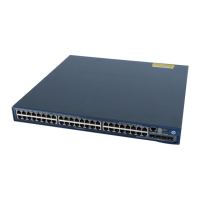171
Port And Protocol VLAN ID
Indicates whether the device supports protocol VLANs and, if so, what VLAN
IDs these protocols will be associated with. An LLDPDU can carry multiple
different TLVs of this type.
Specifies the textual name of any VLAN to which the port belongs. An
LLDPDU can carry multiple different TLVs of this type.
Indicates protocols supported on the port. An LLDPDU can carry multiple
different TLVs of this type.
NOTE:
HP A5120 EI Switch Series supports only receiving protocol identity TLVs.
3. IEEE 802.3 organizationally specific TLVs
Table 25 IEEE 802.3 organizationally specific TLVs
MAC/PHY Configuration/Status
Contains the bit-rate and duplex capabilities of the sending port,
support for auto negotiation, enabling status of auto negotiation,
and the current rate and duplex mode.
Contains the power supply capability of the port, including the
Power over Ethernet (PoE) type, which can be Power Sourcing
Equipment (PSE) or Powered Device (PD), PoE mode, whether PSE
power supply is supported, whether PSE power supply is enabled,
and whether the PoE mode is controllable.
Indicates the aggregation capability of the port (whether the link is
capable of being aggregated), and the aggregation status (whether
the link is in an aggregation).
Indicates the supported maximum frame size. It is now the MTU of
the port.
Indicates the power state control configured on the sending port,
including the power type of the PSE or PD, PoE sourcing and
receiving priority, and PoE sourcing and receiving power.
NOTE:
The Power Stateful Control TLV is defined in IEEE P802.3at D1.0. The later versions no longer support
this TLV. HP devices send this type of TLVs only after receiving them.
LLDP-MED TLVs
LLDP-MED TLVs provide multiple advanced applications for voice over IP (VoIP), such as basic
configuration, network policy configuration, and address and directory management. LLDP-MED TLVs
provide a cost-effective and easy-to-use solution for deploying voice devices in Ethernet. LLDP-MED TLVs
are shown in Table 26:

